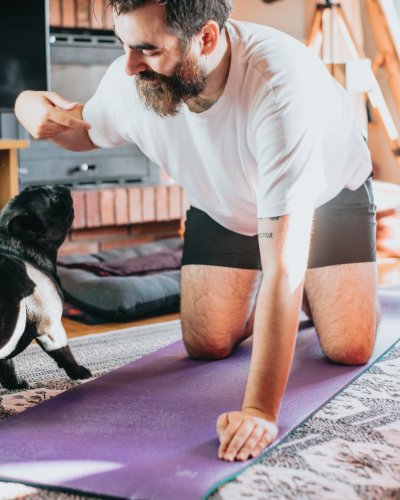Building Canine Athletes: Rest and Recovery
Dog owners and handlers often discuss the nutrition of their pet athletes, strength training exercises, the length of walks or fitness sessions, muscle mass, etc. Although these are essential and well-explored topics for every canine athlete, the lesser-discussed issue of rest and recovery is equally necessary for a dog’s health.
First Steps to Rest: Immediately After the Training Session

At the end of training and exercising, a cool-down period is just as important as a quality warm-up to reduce the risk of injury. The goal is for arousal level, heart rate, blood flow and breathing to gradually decrease so that the dog's organism can adapt to a slower rhythm. During cool down, their muscles will be gently stretched, leading to a lower risk of inflammation.
The cool-down period usually consists of a light trotting, followed by a walk until the dog's breathing has completely calmed down. If the exercises are intense, you can assist your dog by massaging their bodies and limbs. Be sure to observe any signs of fatigue after exercise. Ideally, we don't want our dogs to over-exert themselves during training. Also, assess your dog regularly for signs of injury or discomfort your dog may show after exercise. They are not always manifested through obvious pain but can also be displayed as stiffness or outward signs of aggression.
To reduce the risk of injury during exercises, it's important to work with a qualified canine fitness professional and ensure your fitness plan meets the requirements of your dog.
What Do Proper Rest and Recovery Include?

If you think your dog is too active to love long rest periods, you may be surprised by the following information: adult dogs need 12-14 hours of sleep per day, approximately 50% of the day. Senior dogs require even more. On top of this, dogs can spend an additional 20% of their time relaxing.
One of the most important aspects of rest and recovery is activating the parasympathetic nervous system, also known as the 'rest and digest' state. When our dogs exercise, their bodies increase the blood flow to their large skeletal muscles, providing the necessary oxygen and nutrients to the cells that make movement possible. However, when our dogs relax their bodies and minds, the nervous system that talks with the internal organs (the parasympathetic nervous system) becomes dominant. This allows the body to focus on processing wastes and conducting self-repair functions.
Some dogs, especially those with emotional dysfunctions, can find rest and relaxation more difficult. These dogs will often benefit from an approach that encourages movement to improve cognitive function and separately guides them into deep relaxation. The body and mind are interconnected entities that operate as a system. To optimise their physical health, these dogs must also improve their emotional health.
I have observed dogs who have been taught an 'Off-switch' to still be in a sympathetic dominant state; their mind is alert, and their body is ready to move. If we look at the infographic below, we will see that these dogs are not relaxed, but rather, they are in the preparation stage, preparing for action.
If we are not mindful of the stages dogs must go through to be ready, and we encourage them to live in a state of 'Prepared for action', their ability to rest and recover may be diminished. But by understanding the different stages of readiness, we can encourage our dogs to move more freely between them. Ideally, for their physical and emotional well-being, we want to enable them to move through all stages thoughtfully and rather than impulsively,
We must remember that all dogs are individuals, so teaching and planning for rest and recovery should also be individualised. Teaching our dogs cues that help them move between states of readiness and relaxation will deepen your training through communication on an emotional level and improve your dog's ability to recover from exercise.
Made with Visme Infographic Maker
The Period of Recovery
As explained by Agnieszka Biały, canine physiotherapist and herbalist, the recovery process is complex. Our dog's bodies have individualised self-healing potential that can only restore the body to full function under specific conditions. We can work with our dogs to optimise their recovery by understanding what their bodies need during this time.
In addition to being able to activate their parasympathetic nervous system (rest and digest), two main conditions should be met for the body to become wholly restored. The first is not being exposed to any excessive energy loss - i.e. not exercising during the recovery period. Furthermore, the elements that make up this condition include energy loss when the body struggles with illness, mental stress, unbalanced diet, malnutrition, excessive weight, incorrect rehabilitation, excessive load on the liver and lack of exercise in general in the dog's life.
The second condition dictates that energy must come into the body through moderate movement, sunlight, a complete diet, manual and physical therapy, enough sleep, mental relaxation, relaxing activities, and supplements to strengthen the body.
When these conditions are in balance, a dog's body is best positioned to maximise its ability to renew through the internal regenerative processes.
How Often Should Dogs Have Rest Days?

A rest day is a day your dog uses for physical and mental recovery and should be a crucial part of a dog's exercise routine. It's a whole day of rest, not just a few hours or an evening. However, a rest day for dogs is certainly (or most often) different from a rest day for humans. While people would gladly go to town, beach or spend an afternoon in the forest or at a friend's house, these activities, although still enjoyable, could be too stimulating for dogs. Therefore, the best way for your canine friend to have a quality rest is to spend a somewhat 'boring' day at home.
Owners will have to know their dogs well and detect where they like to spend their time when resting. Some dogs may seek alone time, perhaps in their kennel or another room. Other dogs will be happy relaxing at their owners' company.
Keep in mind that complete recovery means both emotional and mental rest. Although we cannot entirely remove all the triggers that cause restlessness in our dogs, it's still worth reducing them to a minimum on their day of resting. If you know your dog doesn't tolerate guests well, don't invite them that day. Or if you know your dog has trouble staying home alone, stay and bond with your pet, even if it means spending a day lying around - it may be good for you, too. In such situations, remember that canine athletes and working dogs spend a lot of energy while performing their tasks, so they also need a lot of rest when it is time.
Active Rest Days in Canine World
If your dog hasn't undergone long-term intensive training or work, it may be more interested in an active rest day. Active rest day is when dogs maintain a lower activity level instead of lying down all day. In canine fitness sports, the correct name is Active Recovery Day, and the activities it includes can be mild-moderate hiking, trotting, low-intensity swimming, dynamic stretching, or moderate fitness exercises. An equally important part of such a day is the time the dog spends with the owner or a family member, which helps reduce stress levels and benefits emotional health.
Benefits of Active Rest Days

The benefits of active recovery days have been shown on a physiological level: they help dogs flush out toxins and reduce acid buildup. Due to this, dogs' muscles feel less tired while improving the results of training. Furthermore, intense exercise stresses the nervous system, while recovery days reduce the fight and flight response (sympathetic nervous system). During rest, a dog's muscles are restored, and energy storage recovers. Finally, active recovery days help build flexibility, along with strength and endurance, making up the main three segments of sporting dogs' training.
Contrary to all that, when a dog doesn't have regular rest days, its strength, endurance and flexibility decrease and the results of training are lower—the more intense the exercise, if it's not followed by quality rest days, the higher the overall fatigue.
What Not to Do on Active Rest Days
Although the name has the word "active", the emphasis is still on "recovery". On those days, dogs shouldn't participate in any activity that would significantly speed up their heartbeat or breathing.
But apart from physical restrictions, you should know that recovery days also include mental and emotional renewal. Therefore, the dog shouldn't be exposed to any triggers that would cause a physiological response of the fight or flight reaction. We want to keep them in the lower states of readiness shown above.
If on active rest days, your dog appears melancholy and has a lack of interest in activities, your dog may be experiencing fatigue from exessive training, ask yourself whether you may have exhausted your dog too much in the previous days. They may be overcompensating for excessive loss of energy by resting. However, this behaviour can also be a sign of illness or injury. The owner will be the easiest to judge whether it is time to visit the vet.
Plan Your Dog’s Rest and Recovery
Debora Severo, osteopath, human and dog physiotherapist and official therapist of the Czech Agility Team, advises creating a plan for the whole week so that dog owners and dog handlers are more clear about how much they expose their dogs to activities and how much to recovery.
For example, agility dogs can train two to four times a week and, on other days, have long walks with lots of sniffing, where dogs can freely explore the environment. Otherwise, play fun games encouraging moderate activity, such as the snuffle mat game. One day a week must be dedicated to more intensive rest, the day when even walking is primarily intended for potty.
At least once a year, dog athletes must have a more extended rest from training. We are talking about a few weeks during which the dog can still go for long walks, hike or swim, but intensive training during this period should not be part of the plan.






Leave a comment